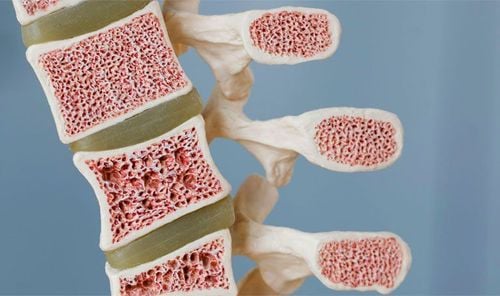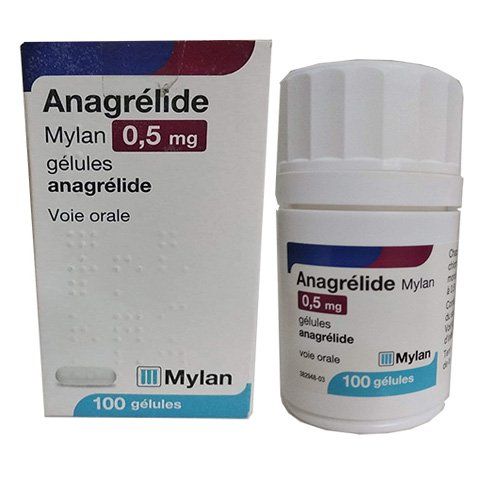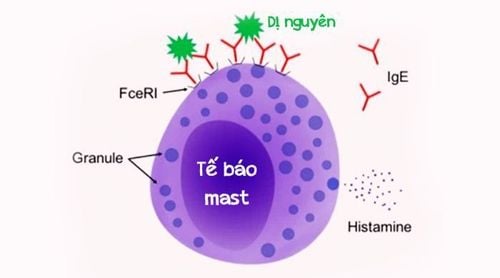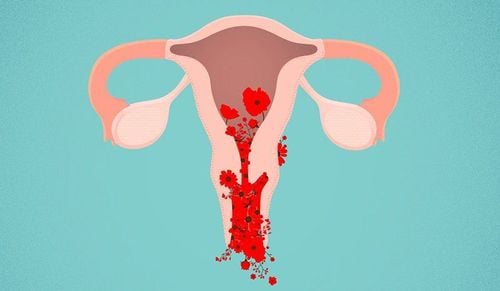This is an automatically translated article.
The article was written by Senior Doctor, Specialist II Doan Du Dat - Head of Medical Examination Unit, Department of Medical Examination and Internal Medicine - Vinmec Ha Long International Hospital.Thrombocytosis (or polyplatelet disease) includes primary thrombocythemia (Thrombocythemia) and secondary thrombocytosis (Thrombocytosis) is a condition in which the number of platelets in the blood exceeds the permissible limit. Platelets are formed in the bone marrow along with other types of blood cells.
Platelets are involved in blood clotting. They stick together (clot walls) to stop bleeding when a blood vessel is damaged, or participate in the formation of a blood clot known as a thrombus, causing an embolism, causing an embolism. so some diseases of cerebral infarction or embolism of extremities, visceral vessels... Normally there are about 150,000-450,000 platelets per microliter of blood (or 150-450 G/L).
1. What is primary thrombocythemia?

Tăng tiểu cầu nguyên phát làm ảnh hưởng đến quá trình đông máu
In this condition, the stem cells in the bone marrow become abnormal and make too many platelets. The cause of this is often unknown. When this process takes place without affecting other blood cells.
There is a rare hereditary form of primary thrombocythemia. In some cases, a genetic mutation causes the condition. In primary thrombocythemia, the platelets are not normal. They can take the form of blood clots, or conversely, cause bleeding when they're not working properly. Bleeding can also occur due to a condition called von Willebrand disease. This condition affects blood clotting. After many years, the disease can progress to fibrosis of the bone marrow.
2. What is secondary thrombocytosis (Thrombocytosis)?
Secondary thrombocythemia occurs when a disease, condition, or foreign agent increases the platelet count. In contrast to primary thrombocythemia, the platelets in secondary thrombocythemia are usually normal.Conditions or factors that can cause thrombocytosis in some cases such as: + Iron deficiency anemia. Hemolytic anemia + After splenectomy + Cancer + Inflammation or infectious diseases such as connective tissue disease, ulcerative colitis, and tuberculosis + Reactions to certain medications. Osteoporosis Some conditions that can lead to short-term thrombocytopenia include: Recovery from severe blood loss Recovery from severe thrombocytopenia caused by excessive alcohol use and a lack of vitamin B12 or folate. ..
3. Consequences of thrombocytosis
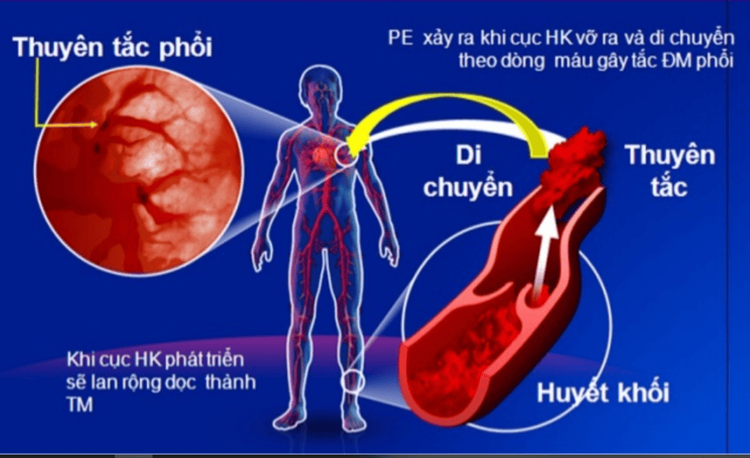
Huyết khối dẫn đến thuyên tắc mạch
Often causes blood clots leading to embolism. Causes Hemorrhage
Thrombosis + In primary thrombocythemia, blood clots often develop in the brain, arms, and legs. But they can occur anywhere in the body, including the heart and intestines.
+ Blood clots in the brain cause stroke causing symptoms in 25% of patients. Common symptoms are chronic headaches and dizziness. A stroke can occur in severe cases. Blood clots in small blood vessels cause numbness and redness in the hands and feet. This can lead to an intense burning sensation and throbbing pain mainly in the palms and soles of the feet.
+ Signs and symptoms of blood clots may include: Blood clots form in the placenta causing fetal death or miscarriage in half of pregnant women with primary thrombocythemia. Blood clots are not only associated with thrombocytopenia, but also with other factors. Age > 60 years, history of blood clots, diabetes mellitus, hypertension, smoking also increase the risk of blood clot formation.
Hemorrhage + Signs of bleeding include nosebleeds, hemorrhagic bruises, bleeding from the mouth or gums, or bloody stools. Although bleeding is often associated with low platelets, it can also occur in people with high platelet counts. Blood clots that form in cases of thrombocytosis can use up the body's platelets. This means that there are not enough platelets left in the blood to mend any cuts or damage to the blood vessels. Another cause of bleeding in patients with very high platelets is von Willebrand disease. This condition affects blood clotting.
4. Diagnostic tests
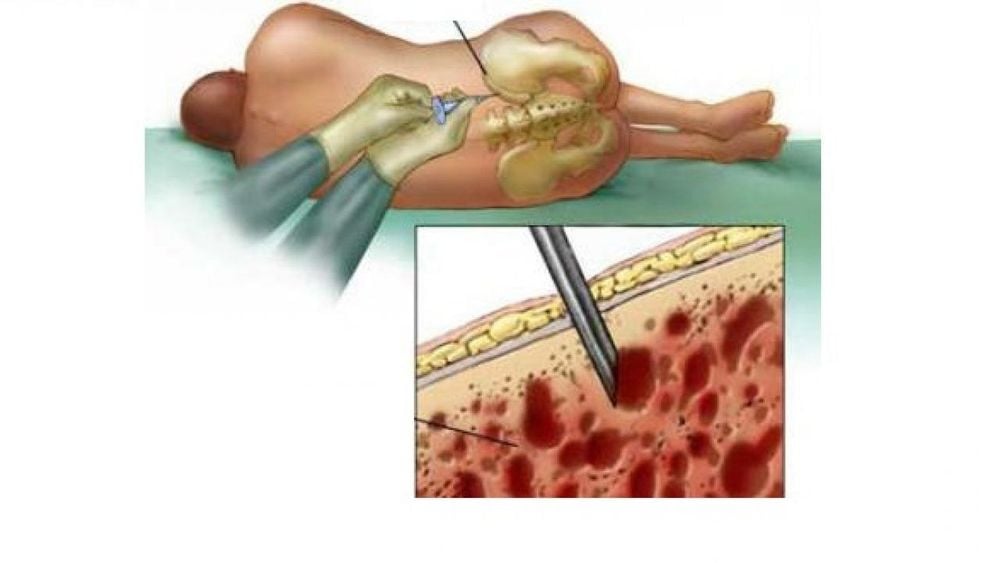
Sinh thiết tủy xương
+ Bone marrow tests : A lumbar puncture to find out if the bone marrow is producing too many platelets. Needle aspiration of some fluid from the bone marrow. Then look at the samples under a microscope to look for defective cells. Or a bone marrow biopsy is usually done right after the aspiration. For this test, the doctor uses a needle to withdraw a small amount of bone marrow tissue. Histological examination to assess the number of cell types in the bone marrow. In cases of primary and secondary thrombocythemia, the bone marrow contains a higher than normal number of macrophages.
+ Other tests such as blood tests to look for genetic factors that can cause thrombocytopenia.
5. Things to keep in mind when you have thrombocytopenia
Go to the doctor regularly. Stop smoking and control risk factors for blood clots, such as high blood pressure, diabetes, high cholesterol, etc. Watch for signs of blood clots and bleeding and report them immediately to your doctor. doctor. Take medications as directed by your doctor. If you are taking medication to lower your platelet count, tell your doctor or dentist before any procedure, surgery or dental intervention. Medications that lower blood platelets can increase bleeding during such procedures. Or it can cause internal bleeding. Signs of internal bleeding include bruising, blood or tarry stools, pink or bloody urine, increased menstrual bleeding, bleeding gums, and nosebleeds. Contact your doctor immediately if you have any of the above symptoms. Avoid over-the-counter pain relievers such as ibuprofen (except paracetamol). These drugs may increase the risk of gastrointestinal bleeding but limit the effects of aspirin. Vinmec International General Hospital is one of the hospitals that not only ensures professional quality with a team of leading doctors, modern equipment and technology, but also stands out for its examination and consulting services. and comprehensive, professional medical treatment; civilized, polite, safe and sterile medical examination and treatment space. Customers when choosing to perform tests here can be completely assured of the accuracy of test results.Please dial HOTLINE for more information or register for an appointment HERE. Download MyVinmec app to make appointments faster and to manage your bookings easily.




